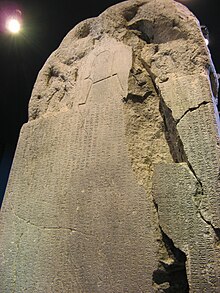| Revision as of 02:10, 21 August 2023 editSmasongarrison (talk | contribs)Extended confirmed users, New page reviewers, Pending changes reviewers, Rollbackers729,704 editsm Moving from Category:8th-century Turkic people to Category:8th-century military personnel Diffusing per WP:DIFFUSE using Cat-a-lot← Previous edit | Revision as of 15:09, 2 February 2024 edit undoBloomingbyungchan (talk | contribs)Extended confirmed users19,934 edits fixed wikilinkNext edit → | ||
| Line 46: | Line 46: | ||
| == Popular culture == | == Popular culture == | ||
| He was portrayed by Ham Suk Hun (함석훈) in Korean TV Series ''].'' | He was portrayed by Ham Suk Hun (함석훈) in Korean TV Series ''].'' | ||
| ==Notes== | ==Notes== | ||
Revision as of 15:09, 2 February 2024
Prince and military commander of the Second Turkic Khaganate| Kül Tegin | |
|---|---|
 Bust of Kul Tigin found at the Khoshoo Tsaidam burial site, in Khashaat, Arkhangai Province, Orkhon River valley. Located in the National Museum of Mongolia. Bust of Kul Tigin found at the Khoshoo Tsaidam burial site, in Khashaat, Arkhangai Province, Orkhon River valley. Located in the National Museum of Mongolia. | |
| Native name | Kültegin Template:Lang-otk |
| Born | 684 |
| Died | February 27, 731(731-02-27) (aged 46–47) |
| Allegiance | Second Turkic Khaganate |
| Rank | Tarkhan (posthumously) |
| Battles / wars | Battle of Bolchu Sogdian Campaign Battle of Iduk Bash Battle of Ming Sha Battle of Sayan Mountains Transoxiana Campaign Battle of Tashkent (713) |
| Memorials | Orkhon inscriptions |
| Relations | Ilterish Qaghan (father) El Bilga Khatun (mother) Bilge Khagan (brother) |
Kul Tigin (Template:Lang-otk Chinese: 闕特勤, Pinyin: Quètèqín, Wade-Giles: chüeh-t'e-ch'in, AD 684–731) was a general and a prince of the Second Turkic Khaganate.
Etymology
Necip Asım (1921) for the first time did read his name as köl, based on the etymology of Mahmud al-Kashgari, meaning "lake, sea". Radloff did read this word as kül, and Thomsen (1896), Malov (1951) and Tekin (1968) adopted this reading. Bazin (1956) and Hamilton (1962) rejected Radloff's reading and preferred the form köl. However, Chinese sources used the Chinese character 闕 (què). Therefore, this word should be read as kül, not köl.
Early years
He was a second son of Ilterish Qaghan, the Second Turkic Khaganate's founder, and the younger brother of Bilge Kaghan, the fourth kaghan. He was seven when his father died.
During the reign of Qapagan Khaghan, Kul Tigin and his older brother earned reputation for their military prowess. They defeated Yenisei Kirghiz, Turgesh, and the Karluks, extending the Kaganate territory all the way to the Iron Gate south of Samarkand. They also subjugated all nine of the Tokuz Oguz tribes.
In 705, Tujue forces commanded by Mojilian entered Lingwu, defeating Shazha Chongyi (沙吒忠义). Kul Tigin commanded a unit in battle, in which he lost three horses.
In 711, he participated in Battle of Bolchu, which was disastrous for Turgesh.
In 713 he participated in subjugation of Karluk tribes with his brother and uncle.
As supreme commander
Upon the death of Qapagan Khaghan, his son Inel Qaghan attempted to illegally ascend to the throne, defying the traditional Lateral succession law, but Kül Tigin refused to recognize the takeover. He raised an army, attacked, and killed Inel, Ashina Duoxifu and his trusted followers. He placed his elder brother Bilge Khagan on the throne, and took the title of Shad, an equivalent of commander-in-chief of the army, for himself.
Death

He died suddenly on 27 February 731. A stele in memory of Kül Tigin, which included inscriptions in both Turkic and Chinese, was erected at his memorial complex of Khoshoo Tsaidam, at the present site of the Orkhon inscriptions. Kül-Tegin is also mentioned in the inscription erected in memory of his older brother Bilge Qaghan at the neighbouring site of Khöshöö-Tsaidam-1.
His burial ceremony took place in 1 November 731. He was posthumously renamed Inanču Apa Yarğan Tarqan (Template:Lang-otk) by Bilge Khagan.
The head of the Kül Tigin sculpture in the Khöshöö-Tsaidam enclave in (Orkhon, in northern Mongolia) carries a bird with wings spread like an eagle, personifying a raven. The head was found by the Czech archeologie Lumir Jisl during his 1957-1958 expedition to Mongolia.
Popular culture
He was portrayed by Ham Suk Hun (함석훈) in Korean TV Series Dae Jo-yeong.
Notes
- erroneously 阙特勒 Quètèlè
References
- ^ Kultegin’s Memorial Complex, TÜRIK BITIG
- Lars Laamann, ed. (1991). Central Asiatic Journal. Vol. 35. p. 48.
- ^ Ahmet., Taşağil (1995–2004). Gök-Türkler. Atatürk Kültür, Dil, ve Tarih Yüksek Kurumu (Turkey). Ankara: Türk Tarih Kurumu Basımevi. ISBN 975161113X. OCLC 33892575.
- Sören Stark, Die Alttürkenzeit in Mittel- und Zentralasien (Nomaden und Sesshafte, Band 6), Reichert: Wiesbaden 2008, pp. 76–78
- Yu. Zuev, "Early Türks: Sketches of history and ideology", Almaty, Daik-Press, 2002, p. 25, ISBN 9985-4-4152-9
Sources
- Talat Tekin, A Grammar of Orkhon Turkic. Indiana University Uralic and Altaic Series, vol. 69 (Bloomington/The Hague: Mouton, 1968)
- 新疆维吾尔自治区民族事务委員会、新疆民族辞典, 乌鲁木齐:新疆人民出版社,1995
External links
- The National Museum of Mongolian History
- Kül Tiğin Inscriptions complete text Archived 2014-01-07 at the Wayback Machine (archived)
- Orkhon inscriptions with translations (contains Kül Tiğin inscriptions with translations, archived)
| Göktürks | |
|---|---|
| First Turkic Khaganate (552–581) |
|
| Eastern Turkic Khaganate (581–630) | |
| Western Turkic Khaganate (581–657) | |
| Second Turkic Khaganate (682–744) | |
| Western Turks under Jimi system |
|
| Göktürk culture | |
| Göktürk wars and battles | |
| Titles | |
| Family | |